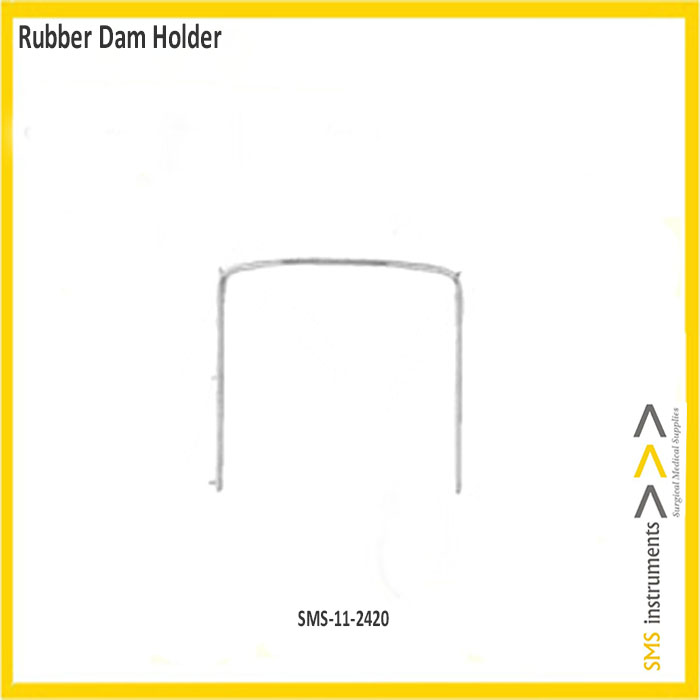Description
Rubber Dam Holder Stainless Steel Pins
Dental Instruments
SMS Instrument Rubber dam frames are skeletons that form dam material. They are contoured to fit close to the face to provide retraction and ample working area for various dental procedures. The frame is used to maintain the border of the rubber dam in position. Stabilizes and stretches the dam so it fits tightly around the teeth and out of the operator’s way. This is also called young’s Frame. It is u – shaped and made of metal. It might interfere with the X-Ray causing obscuring of important structure in the radiograph. It is u-shaped metal frame with small metal projections for securing border of the rubber dam. The instrument is designed with 7 pins, width with 110 mm and lightly curved stainless steel.
| Surname | Holder |
| Working Surface | Smooth with 7 pins |
| Size / Model / Figure | 110 mm |
| curvature | U – Shaped |
| Finishing | Mirror Polish Finishing |
| Instrument Type | Dental Rubber Dam Instruments |
| Material | Stainless Steel |
| Disposable or Reusable | Reusable |
| Rusting Prevention | Passivation Processed |
| Cleaning | Ultrasonic Cleaned |
| Sterile or Non-Sterile | Non-Sterile |
| Latex or Latex-Free | Latex-Free |
| Test Performed | Boil, Shape & Performance Test |
| Grade | Premium OR-Grade |
| Packing | Individually Packed in SMS Brand printed Poly-sleeve |
Rubber Dam Instrument
A Dental Rubber Dam is used mainly in endodontic treatment. The main function of the Rubber Dam Instruments is to isolate the tooth being treated from its environment, in particular from the bacteria in the oral cavity. The rubber dam is held over individual teeth or groups of teeth by appropriate rubber dam clamps or threads (ligatures) along the edge of the gum. The tooth crown stands out from the rubber dam through individual holes made by a whole punch.
Rubber dam provides the best possible isolation by far.
New York City a dentist introduced the rubber dam into dentistry. It is used to define the operating by isolation one or more teeth from oral environment. When excavating a deep carious lesions and risking pulpal exposure, use for the rubber dam is strongly recommended to prevent pulpal contamination from oral fluids. The dam eliminates saliva from the operating site and retract the soft tissue.
Advantage
- Provision of dry clean operating field
- Improvement of access and visibility by eliminating tongue, lip, cheeks and saliva from the operating field
- Retraction and protection of soft tissues.
- Prevention of inhalation and ingestion of foreign bodies
- Improved properties of dental material
- Aid to patient management
- Aid to cross infection control by reducing aerosol spread of micro-organisms.
- Minimization of mouth breathy during inhalation sedation procedures.
Disadvantage
- Usage in low amongst private pracitioners.
- Time consuming and patient objection.
- Cannot be used in case of extremely malpositioned teeth.
- Incorrect use may damage porcelain crown / crown margin / traumatize gingival tissues.
- Insure clamps can be swallowed or aspirated
Uses
Rubber dam is used to isolate for dental procedures
Available different sizes and thicknesses.









